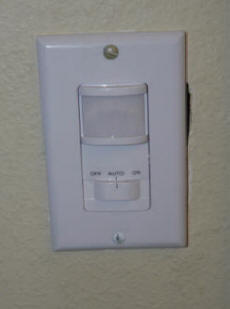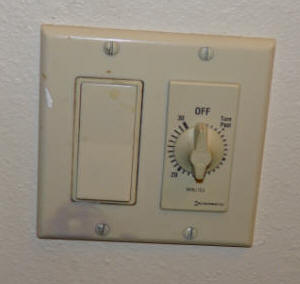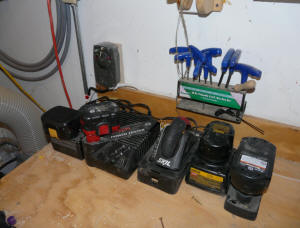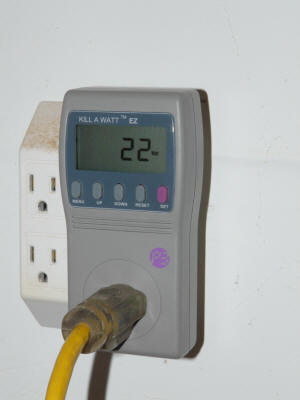
Search
The Renewable Energy site for Do-It-Yourselfers
Using Timers and
Motion Switches to Save Power
| |
|
|
Here are some examples of
using Motion Switches and Timers of various types to make sure things
are turned off when not in use.
Motion Switches
A motion switch can be used
to replace an ordinary wall switch. Once installed, it will turn
on the light (or other device) only when it senses that a person is in
the area.
The ones we use have a three
position switch with: an "off" position, in which the light is always
off, an "auto" position in which the motion detector controls whether
the light is off or on, and an "on" position in which the light is
always on. They also have a control that sets how long the light
stays on after no motion is detected.
These are quick to install,
and, in our experience, work reliably. We currently have one in
the bedroom walk in closet, and one in the kitchen pantry -- these are
lights we were having trouble remembering to turn off. We plan to
add more of them.
An added bonus is that if you
have your hands full of stuff, you don't have to figure out how to flip
the light switch with your elbow.
Be sure to turn off the
circuit breaker for the wall switch before installing the new switch.
See Doug's story below for other uses. |
|
Timers
There are a several types of timers
that 
Wall Switch Replacement Type Timer
These windup timers replace a
standard wall switch. To use them, you turn the timer dial to the amount
of time you want. The light or fan or whatever is on the circuit
controlled by the switch/timer stays on until the timer winds down, and then
shuts off.
Some homes have wall
outlets that are controlled by wall switches. These switches can be
replaced by a timer switch, which will then control anything plugged into the
wall outlet. See below how Doug uses this to keep the kids from leaving
stuff like TVs on.
24 Hour Timers
For things that you want to be on for
a bit every day, the 24 hour dial timers with the
I have a lot of battery operated
tools, and its tempting to leave the chargers plugged in with a battery in them
so that when I want to use the tool, the battery will be charged up. But,
the phantom load from all of those chargers adds up -- in my case it was 19
watts. This is about 170 KWH a year and 300 lbs of CO2 emissions
just to keep the battery tools ready to go. The payback period on the
timer price is less than half a year.
I now use one of the 24 hour plug in
timers to control the chargers for all of the battery
operated tools in the shop. I plug all the chargers into a power strip,
and plug the power strip into the timer. The timer is set to turn on for a
bit each day -- this keeps the batteries for the tools charged up and ready to
use. When I'm not actively working on a project, I just unplug the timer
-- this way all the rechargeable tool chargers are not using any power at all.
Click on pictures to enlarge
|

All of the chargers plugged into power strip
just behind the chargers. Power strip is
then plugged into the timer on the wall
just behind the left most charger. |

With all the chargers at idle after fully
charging their batteries, the KillAWatt
reads a 22 watt phantom load. |
|
Energy Saving Idea For Those Folks
With Kids!
Here is a report from Doug on using
timers and motion switches:
Energy Saving Idea For Those
Folks With Kids!
I had an idea a while back to save on energy consumption. Anyone who has
kids can attest, they leave lights on. The more I ask that they be turned
off, the more frustrated I get. So I put timers on the kid's room lights. I
also put motion sensing switches on the bathroom where I would most
frequently find the light left on. Solved many of the times I would be
running around turning lights off when the kids were nowhere to be found.
Then came the television. I would come into the play room, and the TV, xBox,
VCR/DVD player..... All left on. So I put them on a power strip as suggested
by many, and had the kids start turning that off. But as usual that would
stay on much more often than it would be turned off. SO I thought, why not
employ the same idea of the timer to the power strip? So off to Home Depot I
went and got a bathroom fan timer and a plastic electric box. When I got
home, I nailed the box to the entertainment center. I unplugged the power
strip, and wired the switch in the power strip power cord. Bingo! Now when
the kids want to watch or play games, they have to give the timer a twist.
The TV and games become accessible for up to 60 minutes before having to
re-set the timer.
I know it's a simple fix, but it seemingly has eliminated me having to
remind the kids to turn the TV off!
Gary May 1, 2010

